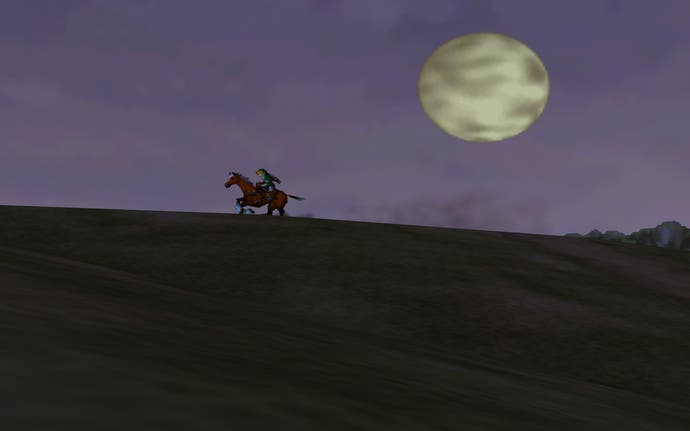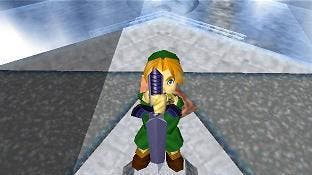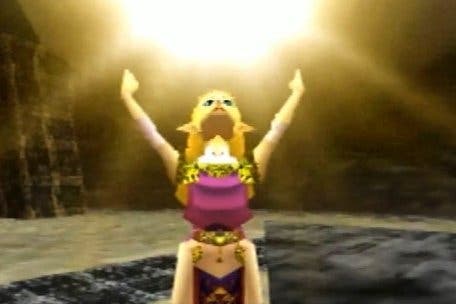25 years ago, The Legend of Zelda: Ocarina of Time became more than a game
Notes from a Ford Orion.
The most vivid memory I have of childhood is sitting in the back of our dirty red Ford Orion on a violet-hued winter evening. Orange beads wash in from passing streetlights and throw chevrons of illumination across me and the boxes I hold close to my body. It's March 1999, we're returning from Norwich with my eighth birthday present, a large box I insist on holding, with a red vertical banner down its face, holding a Nintendo 64. Nestled between it and my chest, where it can't fall, is a smaller box - black and gold - inside of which is a copy of The Legend of Zelda: Ocarina of Time.
The game was released the year before. First in Japan on the 21st November and then a couple of days later in the U.S., before finally appearing in the U.K. on the 11th December. I spent an agonising Christmas watching TV spots, reading magazine features, and knowing I wasn't getting it, staring mournfully instead at the Sega Mega Drive in the corner.
Three months later, however, the Orion's windows are corrugated with rain and Ocarina of Time is so close I can taste it. It's hard to describe how it felt to own my first console in a house in which ownership of my belongings was fluid and influenced mostly by my parents' moods. For this car ride, at least, the Nintendo 64 is mine. That won't stop everyone else taking it: my father to play Castlevania 64 over and over, my brother to pretend it's his when chatting to friends over games of Goldeneye, and my mother to punish me. But on that winter evening, swallowed by the dusty Orion's seats, an N64 and, more importantly, Ocarina of Time belonged to me.
Ocarina of Time entered development in 1995 alongside Super Mario 64. The act of converting the formulae of three 2D The Legend of Zelda titles to 3D proved a challenge, however. Pushing Mario into the third dimension by 1996 had its own obstacles, but the basic tenets remained the same. You run, you jump, you reach the end. The Legend of Zelda, however, was a more complicated beast revolving around combat and exploration. The latter resulted in a more complex and engaging narrative, laden with mandatory collectibles, to give players a meaningful push to explore the extent of Hyrule.
The combat posed more of a problem. Nintendo had found in Super Mario 64 that the question of distance in two-dimensional space was complicated in 3D. The problem of how to judge a jump on a Goomba was never really answered. This lack of depth perception became simply another learning curve for players moving to 3D gaming. That wasn't good enough for Ocarina of Time's swordplay. The result was Z-targeting.
Both of these solutions may seem rudimentary to us now, not least as some form of Z-targeting remains the basis for third-person combat today. But in the late-1990s, we'd never seen anything like it.

It's tempting, with the benefit of a quarter of a century's worth of hindsight, to look at Ocarina of Time through a modern lens, to ply it with nostalgia and recency bias in equal measure in an attempt to re-evaluate it through unfair comparisons. To do so, I believe, would be a mistake. To understand the game 25 years later, you have to understand the mind of that child hugging his copy in the back of his parents' car and appreciate that, in that moment, it wasn't just a game.
I never wanted Ocarina of Time; I dreamed it. Watching Ganondorf loom in 3D against a backdrop of thunder and lightning in its 1998 advert was, to me, the most vivid and magical thing I'd ever seen. And it stayed with me. Watching the advert back now is to remember when wants and needs were startingly simple, when the ability to suspend disbelief came so naturally, and when happiness existed at the end of a video game controller. For a few months, I genuinely believed I needed Ocarina of Time.
I wasn't the only one. The playground filled with children playing "Zelda" long before the game came out. They were joined by pedantic kids like me, pointing out to insecure boys that Zelda was, in fact, the girl, and watching them desperately attempt to shed the role they'd argued most of their playtime to get.

Sent home from school to write a weekend diary, recording my mundane childhood felt pointless. Instead, I wrote an elaborate self-insert story in which I was part of Ocarina of Time's world. Now, it would be regarded as a piece of limp fanfiction. Then it was, according to my teacher, a "cause for concern" that threatened to send me to a psychologist. Such was Ocarina of Time's influence at my school that the headmaster banned pretending to fight with swords - the same square would later ban Pokémon cards.
We'd seen The Legend of Zelda games before, even 3D adventure games. But Banjo-Kazooie, Spyro the Dragon, even Final Fantasy VII - none elicited such an all-encompassing and passionate response. This was something not equalled until Pokémon appeared a year later and eclipsed every other available childhood interest. So, to say Ocarina of Time was one of the most formative experiences of my youth would be far from hyperbole.
Looking back now, we know what Ocarina of Time is. Tens of thousands of words have been devoted to analysing its foundational influence on modern gaming, hundreds of games overtly draw upon it, and it's no surprise that it endures today when most contemporary series have shambled into irrelevance. Yet, 25 years on, I'm not interested in its technical achievements, its influence, or its modern imitators. I think about that child in the back of his parents' car holding onto Ocarina of Time for dear life, frightened it could be taken away, yet for that moment feeling like he had something of his own. No hand-me-downs, no disappointment, only anticipation. For one blissful moment, 25 years ago, for all else it achieved, Ocarina of Time made someone happy.










